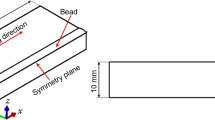Abstract
This study involves thermal, metallurgical and mechanical analysis during tungsten inert gas welding of Ti–6Al–4V alloy aiming at optimizing the welding current to enhance the mechanical properties. Firstly, a 3D transient FEM simulation of TIG Ti–6Al–4V weld using ABAQUS software, based on a Gaussian distribution of power density in space, has been built to predict the effect of welding current on the heat input, weld bead geometry, temperature and residual stresses distribution across the welding line. Secondly, a validation of FEM with the experimentally measured temperature distribution and welding bead geometries has been presented. Finally, experimental study of the effect of TIG welding current, the suitable range predicted from FEM, on the microstructure, hardness and tensile strength of 12-mm-thick alloy plate is discussed. Using FEM, the suitable range of welding current was predicted to be 130–170 A. There was a close agreement among the experimental results and the FEM simulation data. It has been found that low welding current of 130 A results in high tensile strength and hardness of the welding joint. This is attributed to low heat input, high cooling rate and the formation of a fine grain structure containing martensite-phase with low values of residual stresses.

















Similar content being viewed by others
References
Baeslack WA, Davis JR, Cross CE (1998) Selection and weldability of conventional titanium alloys, welding, brazing, and soldering, volume 6, ASM Handbook. ASM International, Materials Park, pp 507–523
Biswas P, Mahapatra MM, Mandal NR (2009) Numerical and experimental study on prediction of thermal history and residual deformation of double-sided fillet welding. J Eng Manuf Proc Inst Mech Eng 224(Part B):125–134
Churiaque C, Amaya-Vazquez MR, Botana FJ, Sánchez-Amaya JM (2016) FEM simulation and experimental validation of LBW under conduction regime of Ti6Al4 V alloy. J Mater Eng Perform 25(8):3260–3269
Esmaily M, Nooshin Mortazavi S, Todehfalah P, Rashidi M (2013) Microstructural characterization and formation of ά martensite phase in Ti–6Al–4 V alloy butt joints produced by friction stir and gas tungsten arc welding processes. Mater Des 47:143–150
Frewin MR, Scott DA (1999) Finite element model of pulsed laser welding. Weld J 78(1):15–22
Fu G, Lourenco MI, Duan M, Estefen SF (2014) Effect of boundary conditions on residual stress and distortion in T-joint welds. J Constr Steel Res 102:121–135
Goldak J, Chakravarti A, Bibby M (1984) A new finite element model for welding heat sources. Metall Trans B 15(2):299–305
Incropera FP, Dewitt DP, Bergman TL, Lavine AS (2006) Fundamentals of heat and mass transfer, 6th edn. Wiley, New York, pp 72–73
Nakhodchi S, Shokuhfar A, Iraj SA, Thomas B (2015) Evolution of temperature distribution and microstructure in multipass welded AISI 321 stainless steel plates with different thicknesses. J Press Vessel Technol 137(6):061405-1–061405-15
Reda R, Hussein A, Nofal A, Sobih M, El-Banna E (2015) Effect of welding processes and postweld heat treatment on the mechanical properties of Ti–6Al–4 V castings. Int J Mater Eng Technol 13(1):1–21
Short A (2009) Gas tungsten arc welding of α + β titanium alloys: a review. Mater Sci Technol 25(3):309–324
Vinokurov VA (1977) Welding stresses and distortion. The British Library, Boston Spa, pp 118–119
Wang RR, Welsch GE (1995) Joining titanium materials with tungsten inert gas welding, laser welding, and infrared brazing. J Prosthet Dent 74:521–530
Yadaiah N, Bag S (2012) Effect of heat source parameters in thermal and mechanical analysis of linear GTA welding process. ISIJ Int 52(11):2069–2075
Yang J, Sun S, Brandt M, Yan W (2010) Experimental investigation and 3D finite element prediction of the heat affected zone during laser assisted machining of Ti6Al4 V alloy. J Mater Process Technol 210(15):2215–2222
Author information
Authors and Affiliations
Corresponding author
Rights and permissions
About this article
Cite this article
Reda, R., Magdy, M. & Rady, M. Ti–6Al–4V TIG Weld Analysis Using FEM Simulation and Experimental Characterization. Iran J Sci Technol Trans Mech Eng 44, 765–782 (2020). https://doi.org/10.1007/s40997-019-00287-y
Received:
Accepted:
Published:
Issue Date:
DOI: https://doi.org/10.1007/s40997-019-00287-y




